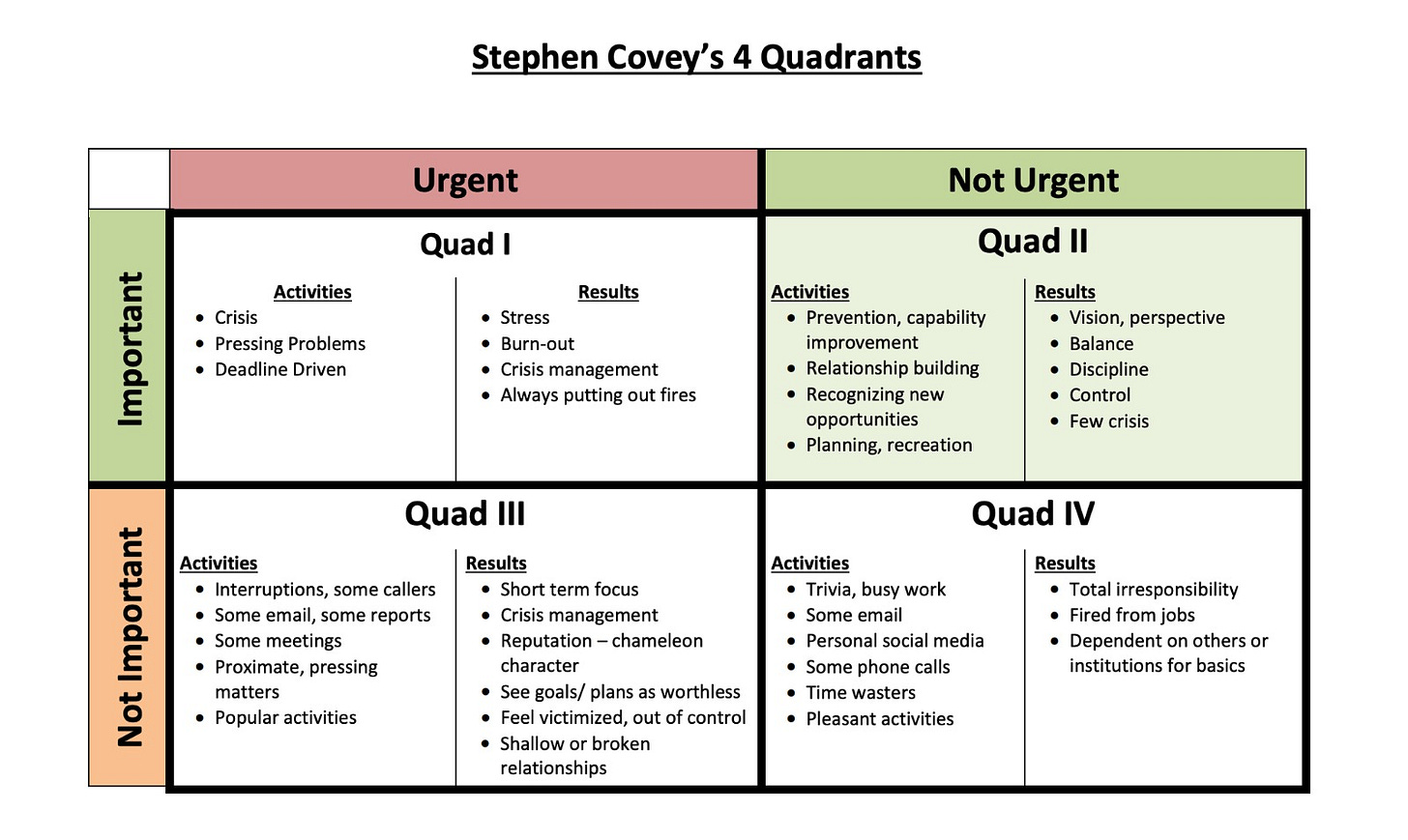Time vs energy management
Where you are headed is more important than how fast you are going. Rather than always focusing on what's urgent, learn to focus on what is really important. ~ Stephen Covey
Urgent and important
One of the characteristics of my job is that I deal primarily with incidents and crises. These often come with high levels of pressure and stress. In some cases, you are often informed about an issue without the necessary information to know what to communicate or do, in other cases, you may be swamped with too much information that you have to inquire again, as slowly as possible, to put all the pieces together in your head. But in all cases, you are forced to work in an environment where everything is urgent [as minutes could be worth millions] and your actions are consequential [because your mistakes lead to reputational damage]. Usually at the end of the day, I recall my brain feeling totally fried.
A few weeks ago, I was speaking with a mentor about my energy levels and about some days when I had “free time”, but didn’t have the energy or motivation to plow through the checklist of the day or week. This led us to discussing Stephen Covey’s 4 quadrants of activities below:
As you can see from the table above, when we only do work that is Urgent and Important, we have increased chances of stress, burn-out, crisis and a sense that there’s always fires to be put out. In addition, when we spend a lot of time performing activities in the other less ideal areas in the table, Urgent and Not Important, and Not Urgent and Not Important, we may have more work pile in the Urgent and Important category, asides other negative consequences that may be a direct result of these activities. Hence, poor time management can lead to mid- to long-term bad energy management.
Important, but not Urgent
The benefits
The benefits of getting to spend time on Important, but not Urgent tasks has multiple direct benefits for the mind and body, as well as indirect benefits that reflect on our relationships, work and long-term well-being.
Improved focus on priorities and time management: Activities in this category are often related to personal growth, planning, and relationship building. This helps in proactive management of responsibilities rather than reactive. Spending time to organize tasks so that you can allocate appropriate time to the most important activities leads to a more structured and productive schedule.
Enhanced decision making: Having a clear framework for deciding which tasks deserve attention and which can be delegated, deferred, or eliminated allows you to be more efficient and leave the rest to the actual experts. As a consequence, you also develop a clearer mind when you have less things to remember or need you to act on in the short-term.
Better use of resources: Ensuring that the most of your time, energy, and resources are invested in tasks that yield the highest return on investment, both professionally and personally, leads to … (you guessed it) the highest return of your time, energy and resources.
Enhanced self-discipline: When we spend time thinking, planning and acting for the long-term, a higher sense of self-discipline is developed through the process, reducing the tendency to procrastinate in the short-term.
The process
Developing a lifestyle that is primarily a lot on Quadrant II (Important, but not Urgent tasks) activities is indeed a process because you can’t just drop everything you do today and suddenly start working on less urgent work. In the past few weeks, I started developing a framework, also from Stephen Covey, on how to make this gradual transition.
Identify Quadrant II activities: Clearly define your long-term goals and objectives, both personal and professional. Additionally, identify activities that contribute to these goals, such as planning, relationship building, skill development, and self-care.
Schedule dedicated time: allocate specific times in your daily or weekly schedule for Quadrant II activities. Treat these appointments with the same level of importance as meetings or deadlines. Use time-blocking techniques to ensure you set aside uninterrupted time for important tasks. Review your progress, reflect on what worked and what didn’t, and adjust your plan accordingly.
Prioritize, delegate, ask for help: Use a task management system to prioritize important activities over urgent but less important ones. Delegate tasks that others can do and eliminate non-essential tasks that fall into Quadrants III (Urgent but Not Important) and IV (Not Urgent and Not Important).
Set clear boundaries: Minimize distractions and interruptions by setting clear boundaries, such as designated work hours or a “do not disturb” sign during focused work periods. Reduce time spent on low-value activities such as excessive meetings, social media, or trivial tasks.
Develop habits and routines: Start your day with a morning routine that includes planning, goal-setting, and focusing on your most important tasks. Regularly review and adjust your schedule and priorities to ensure you are staying aligned with your goals.
Enhance self-discipline: Break down long-term goals into smaller, manageable tasks to make them less overwhelming and more achievable. Use accountability partners or tools to stay committed to your Quadrant II activities.
Utilize resources and seek support: Invest in training, tools and resources that help you develop better time management and productivity skills. Seek guidance from mentors or coaches who can provide insights and support in prioritizing important tasks. Be open to learning from your experiences and making necessary adjustments to improve your focus on Quadrant II activities.
By consciously implementing these strategies, you can gradually shift your focus towards Quadrant II activities, leading to more proactive, goal-oriented, and fulfilling personal and professional life.





